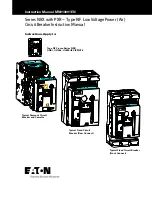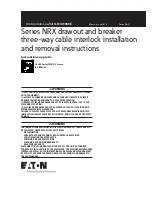
For more information visit: www.EatonElectrical.com
Instructions for VR-Series
Replacement Breakers for
Westinghouse Type B20B/B22B
IB01301018E
I.B. 94A1994R01
Page 16
Effective: April 2005
Figure 5-1 B20B/B22B-VR Interrupter
Figure 5-2 B20B/B22B-VR Interrupter Assembly
SECTION 5: DESCRIPTION AND OPERATION
VR-Series vacuum replacement breakers are designed to be used
with existing installations of equivalent air-magnetic metal-clad
switchgear breaker. The front mounted spring type stored energy
mechanism facilitates inspection and provides improved access to
components for servicing. The long life characteristics of the
vacuum interrupters and proven high reliability of spring-type stored
energy mechanisms assure long, trouble-free service with minimum
maintenance.
5.1 VACUUM INTERRUPTER
Vacuum interrupters offer the advantages of enclosed arc
interruption, small size and weight, longer life, reduced mainte-
nance, minimal mechanical shock, and elimination of contact
degradation caused by environmental contamination.
In the closed position, current flows through the interrupter moving
and fixed stems and the faces of the main contacts. As the contacts
part, an arc is drawn between the contact surfaces. The arc is
rapidly moved away from the main contacts to the slotted contact
surfaces by self-induced magnetic effects. This minimizes contact
erosion and hot spots on the contact surfaces. The arc flows in an
ionized metal vapor and as the vapor leaves the contact area, it
condenses into the metal shield which surrounds the contacts.
At current zero, the arc extinguishes and vapor production ceases.
Very rapid dispersion, cooling, recombination, and deionization of
the metal vapor plasma and fast condensation of metal vapor
causes the vacuum to be quickly restored and prevents the transient
recovery voltage from causing a restrike across the gap of the open
contacts.
5.1.1 THE INTERRUPTER ASSEMBLY
Each interrupter is assembled at the factory as a unit to assure
correct dimensional relationships between working components.
The interrupter assembly consists of a vacuum interrupter, a molded
glass polyester stand-off insulator, upper and lower clamps, flexible
shunts, bell crank, operating rod, and contact load spring. The
vacuum interrupter is mounted vertically with the fixed stem upward
and the moving stem downward. The upper and lower glass
polyester stand-off insulator and clamps support the interrupter and
are fastened to the breaker’s stored energy mechanism frame.
Upper and lower flexible shunts provide electrical connections from
each interrupter to the breaker’s primary bushings while providing
isolation from mechanical shock and movement of the interrupter’s
moving stem. The operating rod, loading spring, and bell crank
transfer mechanical motion from the breaker’s operating mechanism
to the moving stem of the interrupter. A vacuum interrupter erosion
indicator is located on the moving stem of the interrupter. It is visible
when the breaker is withdrawn and is viewed from the rear of the
breaker. (See Figure 6-3)
5.1.2 CONTACT EROSION INDICATOR
When contact erosion reaches 1/8 inch, the interrupter assembly
must be replaced. The contact erosion indicator is a horizontal line
marked on the moving stem of the interrupter (See Figure 6-2 and
6-3).
To judge erosion, close the breaker and view the erosion mark on
each vacuum interrupter moving stem. When the vacuum inter-
rupter is new, the mark is approximately 1/8 inch below the stem
guide. If the mark is no longer visible (because it has moved under
the stem guide), the interrupter is at the end of its allowable wear,
and the complete interrupter assembly must be replaced.








































